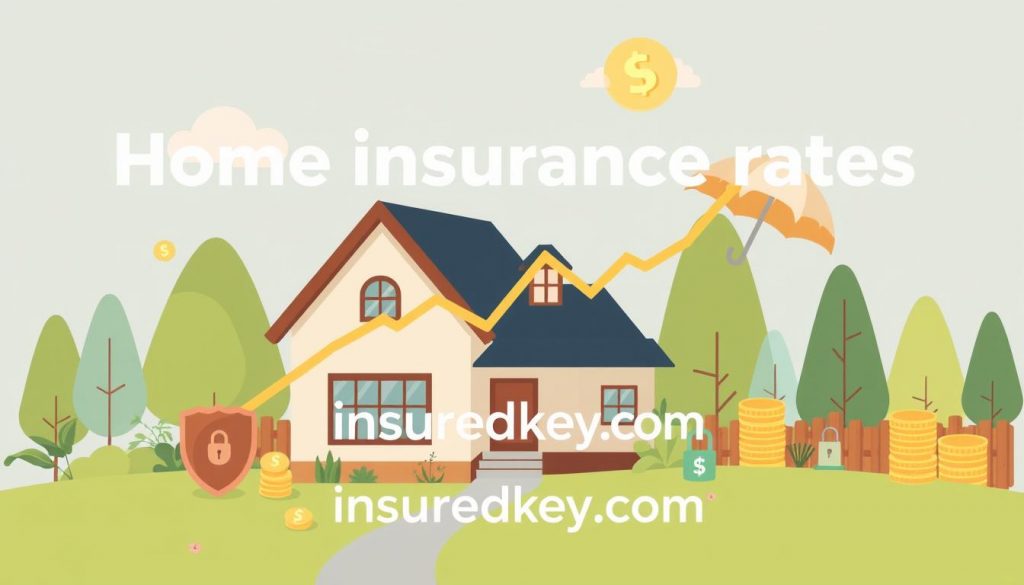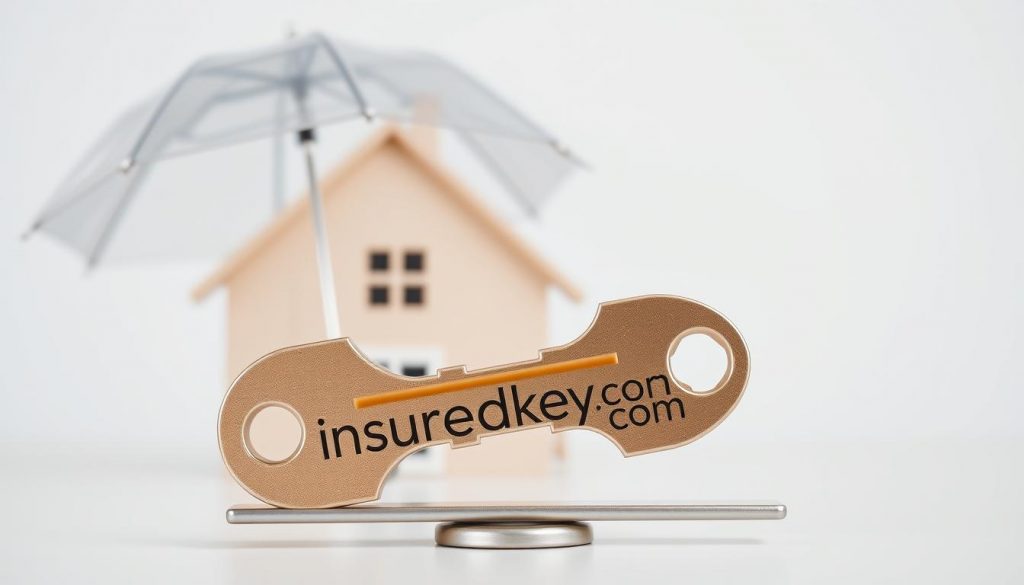Home insurance is key to protecting your biggest asset—your home. It gives you peace of mind by covering your property and belongings against unexpected events like fires, storms, and theft. With a good homeowners insurance policy, you can avoid big costs from damage or liability claims.
Knowing the different home insurance options helps you pick the right one for you. This ensures your family and property are well-protected. It’s a smart way to secure your home’s future.
Key Takeaways
- Homeowners insurance provides essential financial protection against damage or loss.
- Customizable coverage options include personal property, liability, and additional living expenses.
- Discounts are often available for bundling homeowners insurance with other policies.
- Factors impacting insurance rates include location, home condition, and safety features.
- Understanding exclusions and additional coverages is vital for comprehensive insurance coverage.
Understanding Home Insurance Basics
Home insurance is a key safety net for your property. It guards against many risks and damages. This can greatly affect your financial health and investment. Knowing the basics of homeowners insurance is crucial. It covers different types of risks for homeowners.
What is Home Insurance?
Home insurance, also known as homeowners insurance, is a policy to protect your home and belongings. It covers four main areas:
- Residential Structure Damage: It protects your home’s physical structure.
- Personal Property Loss: It covers your belongings inside the home, usually 50% to 70% of the home’s value.
- Liability Protection: It offers financial help if someone gets hurt or damages your property, starting at $100,000.
- Additional Living Expenses: It pays for temporary living costs if your home is damaged and can’t be lived in.
Why Do You Need It?
Home insurance is very important. Here’s why:
- It helps you financially recover from unexpected disasters or accidents.
- It covers more than just your house, like garages and sheds.
- Liability insurance helps with legal costs if someone gets hurt on your property.
Your policy can also include special coverage for valuable items like jewelry. Without it, you could face huge financial losses. This could harm your future.
Types of Home Insurance Policies
Choosing the right home insurance policy can be tough. Knowing the different types helps you pick the best one for you. There are three main types: HO-1 Basic Form, HO-3 Special Form, and HO-5 Comprehensive Form. Each offers unique coverage for various needs.
HO-1: Basic Form
The HO-1 policy is called the Basic Form. It protects against eleven specific dangers like fire and windstorms. However, it doesn’t cover personal property or liability. Many lenders won’t accept HO-1 policies because of their limited scope.
HO-3: Special Form
The HO-3 policy, or Special Form, is the most popular choice. It guards your home against all dangers except those not listed in the policy. It also covers personal property and liability, offering financial help in lawsuits.
HO-5: Comprehensive Form
The HO-5 policy, or Comprehensive Form, offers the most protection. It covers most dangers and pays for personal property losses based on replacement cost. This means it often covers more than other policies. With fewer limits and more coverage, HO-5 is great for those wanting full insurance.
Key Coverage Options to Consider
Choosing the right home insurance policy is crucial. It’s important to know the key coverage options. Each option helps protect your home and belongings from unexpected events.
Dwelling Coverage
Dwelling coverage is the core of your home insurance. It protects your home’s structure from hazards like fire and windstorms. Most policies cover 50% to 70% of your home’s value.
Knowing your dwelling coverage limits is key. It helps safeguard your biggest investment.
Personal Property Coverage
Personal property coverage is also vital. It protects your belongings from theft, loss, or damage. This includes furniture, electronics, and personal items.
Many policies cover your belongings at Actual Cash Value or Replacement Cost. If you have high-value items, consider extra coverage. This ensures your most valuable possessions are fully protected.
Liability Protection
Liability insurance is essential for your financial safety. It covers you if someone gets hurt on your property or if you accidentally damage someone else’s property. Experts recommend at least $300,000 worth of coverage.
An umbrella policy can offer even more protection. It covers legal costs, medical bills, and settlements. This gives you peace of mind in today’s litigious world.
Factors Affecting Home Insurance Rates
Knowing what affects home insurance rates can help you find good deals. Many things can change how much you pay for coverage.
Location of Your Home
Where your home is located greatly affects insurance rates. Places at risk for natural disasters like hurricanes or wildfires have higher rates. For example, Florida’s high risk for hurricanes means homeowners pay over $4,000 a year.
In contrast, Hawaii has some of the lowest rates. But, homes in Tornado Alley can see rates up to 50% higher than the national average.
Home’s Age and Condition
The age and condition of your home also play a big role. Older homes, especially those without modern safety features, can cost 75% more to insure. Well-kept homes usually get lower quotes, while neglected ones may see higher rates.
Coverage Amount
The amount of coverage you choose also matters. More coverage means higher premiums because of the risk to the insurer. For instance, a $150,000 home might cost $1,274 a year, while a $750,000 home could be $4,824 annually.
How to Choose the Right Home Insurance
Finding the right home insurance policy is important. You need to think about what you need based on your home’s value and your belongings. Everyone’s situation is different, so you need a policy that fits you.
Assess Your Coverage Needs
Think about what you want to protect. Home insurance covers many things, like your home and personal items. Knowing the value of your home and what’s inside helps you find the right policy.
Compare Quotes from Multiple Providers
Getting home insurance quotes from different companies is key. It lets you see which policies are best for you and your budget. Remember, quotes can change based on things like deductibles and coverage limits.
Read Customer Reviews
What others say about an insurer matters a lot. Reading reviews can tell you about a company’s service and how they handle claims. Good customer service means your home is in safe hands. Look for feedback that matches what you’re looking for.
The Role of Deductibles in Home Insurance
Understanding your home insurance deductible is key to managing your policy well. A deductible is the amount you pay before your insurance kicks in after a claim. The average deductible is about $1,000, but it can vary a lot.
What is a Deductible?
A deductible is like a starting point for your insurance to help with a claim. Deductibles usually range from $100 to $5,000. This means you pay that amount first before getting any insurance help. Choosing a higher deductible can lower your premiums, saving you money.
However, it’s important to think about your financial situation and if you can handle unexpected costs.
Choosing the Right Deductible Amount
Choosing the right deductible is a big decision for your insurance plan. Consider a few things:
- Your financial situation: Can you afford the deductible if you need to make a claim?
- Future plans: How might your life change in the next few years?
- Potential risks: What risks in your area might lead to claims?
Finding the right balance between deductible and premium can improve your coverage while keeping costs down. Remember, not all parts of your homeowners policy need a deductible. This lets you tailor your coverage as you see fit.
Common Exclusions in Home Insurance Policies
It’s important for homeowners to know about home insurance exclusions. Knowing what damages and situations are not covered can help you plan and avoid unexpected costs. Here, we look at common exclusions in property insurance policies.
Natural Disasters
Many think their policy covers all damage, but natural disasters are often not included. For example, flooding from heavy rain or ground seepage is usually not covered. Earthquakes and landslides also need separate coverage.
Home Business Activities
If you run a business from home, your policy might not cover business-related issues. This means damage or losses from your business might not be covered. You should get endorsements for home businesses to protect yourself.
Wear and Tear
Wear and tear, or routine maintenance issues, are often not covered. Damage from neglect or aging is not included. Keeping up with maintenance is key, as insurance doesn’t cover these problems.
Tips for Lowering Your Home Insurance Premiums
Finding ways to lower home insurance premiums can save you money. A few strategies can help you get affordable insurance without sacrificing coverage. Here are some tips to cut your costs:
Bundling with Other Insurance Policies
Many insurers give big insurance discounts if you bundle home and auto policies. You could save 5% to 15%. It’s worth comparing to see who offers the best deal.
Improving Home Security
Boosting your home’s security can lower your insurance costs. Installing safety features like smoke detectors and alarms can get you discounts of 5% to 15%. Upgrades like new roofs and storm-resistant features also help lower rates.
Maintaining a Good Credit Score
A good credit score is key to lower insurance rates. Insurers see people with better credit as less risky. Keeping your finances in check can help you stay attractive to insurers.
| Strategy | Potential Discount |
|---|---|
| Bundling Policies | 5% to 15% |
| Home Security Upgrades | 5% to 15% |
| Good Credit Score | Varies by insurer |
| Long-term Loyalty Discounts | 5% to 10% |
| Deductible Increase | Up to 25% |
Keep an eye on your policy and stay with the same insurer. Also, take advantage of discounts. Being proactive can help you get the best affordable home insurance deals.
The Claims Process: What to Expect
The claims process can be complex after a damaging event to your home. Knowing how to navigate it can greatly help. Being ready can lessen the stress of this necessary step.
Reporting a Claim
To start the claims process, quickly call your insurance provider. Give them all the details about the incident clearly. Most policies need claims filed within a year of the disaster.
The sooner you report the claim, the faster help will come.
Documentation Needed
Having all the right documents is key for a smooth claims process. Here’s what you might need:
- Photographs of damages
- Repair estimates
- Incident reports
Insurance companies need accurate documents to understand the loss. If personal items get damaged, the first check is usually the item’s cash value. To get full replacement value, you might need to show proof of purchase within a certain time.
How Claims are Processed
After you file a claim, your insurer has 15 business days to respond. They then have another 15 days to decide on payment. If your claim is approved, you’ll get a payment based on the damage estimate.
If your home is not livable, you might get a check for temporary housing. The claims process can change based on your policy and limits. Insurers must pay for all or part of the claim, following state laws and your policy.
Enhancing Your Home Insurance Knowledge
It’s important to keep learning about home insurance to have the right coverage. There are many resources for homeowners, like insurance websites, advocacy groups, and financial advisors. These help you stay up-to-date with changes in homeowners insurance, including new policies or laws.
Resources for Homeowners
There are many ways to learn about your insurance options. Talking to local agents can give you advice that fits your needs. Community groups also share tips and experiences that might help you save money.
Knowing about the latest improvements, like security systems or better plumbing, can also help. It can make you feel safer and might even lower your insurance costs.
Staying Updated on Policy Changes
It’s a good idea to check your policy with an agent often. This way, you can spot any updates that could improve your coverage. For example, updating your electrical system can save you money and make your home safer.
By staying informed and proactive, you can protect your home better and maybe even save money. Making upgrades to your home can lead to better insurance deals.
FAQ
What types of events does home insurance typically cover?
Home insurance usually covers fires, storms, theft, and vandalism. It might also cover your personal property and protect you from liability.
How can I determine the right amount of dwelling coverage?
To find the right coverage, think about how much it would cost to rebuild your home. Consider local construction costs and any upgrades you’ve made.
Are there specific discounts available for home insurance?
Yes, you can get discounts for bundling policies, installing security systems, and having a good credit score. Always ask your insurer about discounts you might qualify for.
What should I do if I need to file a claim?
If you need to file a claim, call your insurance provider right away. Tell them about the incident and gather photos and repair estimates.
Is flood coverage included in a typical home insurance policy?
No, flood coverage is usually not part of standard home insurance. You might need to buy separate flood insurance or endorsements for flood damage.
Can I customize my homeowners insurance policy?
Yes, you can tailor your homeowners insurance to fit your needs. This might include adding coverage for specific items, increasing liability, or changing deductibles.
How often should I review my home insurance policy?
Review your policy at least once a year or after big changes, like renovations or new family members. This ensures you have the right coverage.
What do I need to know about home insurance deductibles?
A deductible is what you pay before insurance kicks in. Choosing a higher deductible can lower your premium. But make sure you can afford it if you need to make a claim.
How can I save money on my home insurance premiums?
To save on premiums, bundle policies, improve your home’s security, keep a good credit score, and compare quotes from different providers.
What is the process for renewal of my home insurance policy?
Home insurance policies usually renew automatically. But it’s smart to review your coverage before renewal. Check for any changes in premium or coverage options.


